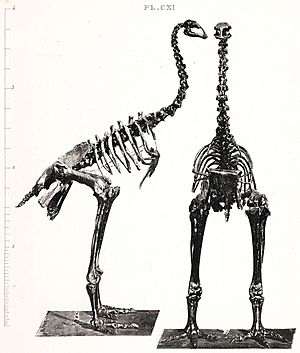Bush moa facts for kids
Quick facts for kids Bush moaTemporal range: Pleistocene-Holocene
|
|
|---|---|
 |
|
| skeleton | |
| Conservation status | |
| Scientific classification | |
| Genus: |
Anomalopteryx
|
| Species: |
didiformis
|
| Synonyms | |
|
Dinornis didiformis Owen, 1844 |
|
The bush moa or lesser moa (Anomalopteryx didiformis) was a type of moa, a large, flightless bird that used to live in New Zealand. It was about 1 meter (3.3 feet) tall and weighed around 30 kilograms (66 pounds). This bird, along with the much larger giant moa, roamed across most of New Zealand's North Island and parts of the South Island. Sadly, like all moa species, the bush moa is now extinct.
Contents
What Was the Bush Moa?
The bush moa was one of the smaller types of moa. Moa were unique birds because they couldn't fly. Instead, they had strong legs for walking and running. The bush moa got its name because it often lived in forests and bushland areas.
Appearance and Size
Imagine a bird that looked a bit like a giant kiwi or an emu, but without wings! The bush moa had a sturdy body, a long neck, and a small head. Its feathers were likely brown or grey, helping it blend into the forest. At about 1 meter tall, it was roughly the height of a 10-year-old child. It weighed about as much as a large dog.
Where Did It Live?
The bush moa lived all over the North Island of New Zealand. It also lived in some parts of the South Island, especially in the northwest and south. They preferred areas with dense forests and shrublands, where they could find plenty of food and shelter.
Life of the Bush Moa
These birds were an important part of New Zealand's ancient ecosystem. They spent their days foraging for food and moving through the dense vegetation.
What Did They Eat?
Bush moa were herbivores, meaning they ate plants. Their diet likely included leaves, twigs, seeds, and fruits from the many native plants in New Zealand's forests. They probably used their strong beaks to snip off tough plant material.
How Long Did They Live?
Scientists study the bones of moa to learn about their lives. It's believed that moa, including the bush moa, could live for many years, possibly up to 50 years or more, similar to other large, long-lived birds.
Why Did the Bush Moa Disappear?
The bush moa, along with all other moa species, became extinct around the 15th century. This happened shortly after humans, the Māori, arrived in New Zealand.
Human Arrival and Hunting
When the Māori people first arrived in New Zealand, they found a land full of unique animals, including the moa. Moa were a valuable source of food, feathers, and bones. The Māori hunted moa for these resources. Because moa were large, flightless, and had no natural predators before humans arrived, they were easy to hunt.
Habitat Loss
As human populations grew, forests were cleared for settlements and farming. This meant that the bush moa lost much of its natural home. The combination of hunting and habitat loss led to a rapid decline in moa numbers.
Extinction
Within a few hundred years of human arrival, all species of moa, including the bush moa, had disappeared forever. Their extinction is a sad reminder of how human actions can impact the natural world.
Images for kids
See also
- Moa
- Extinction
- In Spanish: Moa de los arbustos para niños


